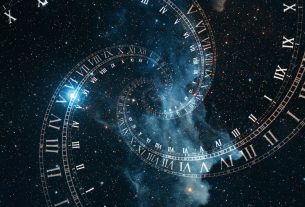One of the most startling scientific discoveries of recent decades is that physics appears to be fine-tuned for life. This means that for life to be possible, certain numbers in physics had to fall within a certain, very narrow range.
One of the examples of fine-tuning which has most baffled physicists is the strength of dark energy, the force that powers the accelerating expansion of the universe. If that force had been just a little stronger, matter couldn’t clump together. No two particles would have ever combined, meaning no stars, planets, or any kind of structural complexity, and therefore no life.
If that force had been significantly weaker, it would not have counteracted gravity. This means the universe would have collapsed back on itself within the first split-second – again meaning no stars or planets or life. To allow for the possibility of life, the strength of dark energy had to be, like Goldilocks’s porridge, “just right”.
This is just one example, and there are many others.
The most popular explanation for the fine-tuning of physics is that we live in one universe among a multiverse. If enough people buy lottery tickets, it becomes probable that somebody is going to have the right numbers to win. Likewise, if there are enough universes, with different numbers in their physics, it becomes likely that some universe is going to have the right numbers for life.
For a long time, this seemed to me the most plausible explanation of fine-tuning. However, experts in the mathematics of probability have identified the inference from fine-tuning to a multiverse as an instance of fallacious reasoning – something I explore in my new book, Why? The Purpose of the Universe. Specifically, the charge is that multiverse theorists commit what’s called the inverse gambler’s fallacy.
Suppose Betty is the only person playing in her local bingo hall one night, and in an incredible run of luck, all of her numbers come up in the first minute. Betty thinks to herself: “Wow, there must be lots of people playing bingo in other bingo halls tonight!” Her reasoning is: if there are lots of people playing throughout the country, then it’s not so improbable that somebody would get all their numbers called out in the first minute.
But this is an instance of the inverse gambler’s fallacy. No matter how many people are or are not playing in other bingo halls throughout the land, probability theory says it is no more likely that Betty herself would have such a run of luck.
It’s like playing dice. If we get several sixes in a row, we wrongly assume that we are less likely to get sixes in the next few throws. And if we don’t get any sixes for a while, we wrongly assume that there must have been loads of sixes in the past. But in reality, each throw has an exact and equal probability of one in six of getting a specific number.
Hlorgeksidin/Shutterstock
Multiverse theorists commit the same fallacy. They think: “Wow, how improbable that our universe has the right numbers for life; there must be many other universes out there with the wrong numbers!” But this is just like Betty thinking she can explain her run of luck in terms of other people playing bingo. When this particular universe was created, as in a die throw, it still had a specific, low chance of getting the right numbers.
At this point, multiverse theorists bring in the “anthropic principle” – that because we exist, we could not have observed a universe incompatible with life. But that doesn’t mean such other universes don’t exist.
Suppose there is a deranged sniper hiding in the back of the bingo hall, waiting to shoot Betty the moment a number comes up that’s not on her bingo card. Now the situation is analogous to real world fine-tuning: Betty could not have observed anything other than the right numbers to win, just as we couldn’t have observed a universe with the wrong numbers for life.
Even so, Betty would be wrong to infer that many people are playing bingo. Likewise, multiverse theorists are wrong to infer from fine-tuning to many universes.
What about the multiverse?
Isn’t there scientific evidence for a multiverse though? Yes and no. In my book, I explore the connections between the inverse gambler’s fallacy and the scientific case for the multiverse, something which surprisingly hasn’t been done before.
The scientific theory of inflation – the idea that the early universe blew up hugely in size – supports the multiverse. If inflation can happen once, it is likely to be happening in different areas of space – creating universes in their own right. While this may give us tentative evidence for some kind of multiverse, there is no evidence that the different universes have different numbers in their local physics.
There is a deeper reason why the multiverse explanation fails. Probabilistic reasoning is governed by a principle known as the requirement of total evidence, which obliges us to work with the most specific evidence we have available.
In terms of fine-tuning, the most specific evidence that people who believe in the multiverse have is not merely that a universe is fine-tuned, but that this universe is fine-tuned. If we hold that the constants of our universe were shaped by probabilistic processes – as multiverse explanations suggest – then it is incredibly unlikely that this specific universe, as opposed to some other among millions, would be fine-tuned. Once we correctly formulate the evidence, the theory fails to account for it.
The conventional scientific wisdom is that these numbers have remained fixed from the Big Bang onwards. If this is correct, then we face a choice. Either it’s an incredible fluke that our universe happened to have the right numbers. Or the numbers are as they are because nature is somehow driven or directed to develop complexity and life by some invisible, inbuilt principle. In my opinion, the first option is too improbable to take seriously. My book presents a theory of the second option – cosmic purpose – and discusses its implications for human meaning and purpose.
This is not how we expected science to turn out. It’s a bit like in the 16th century when we first started to get evidence that we weren’t in the centre of the universe. Many found it hard to accept that the picture of reality they’d got used to no longer explained the data.
I believe we’re in the same situation now with fine-tuning. We may one day be surprised that we ignored for so long what was lying in plain sight – that the universe favours the existence of life.



